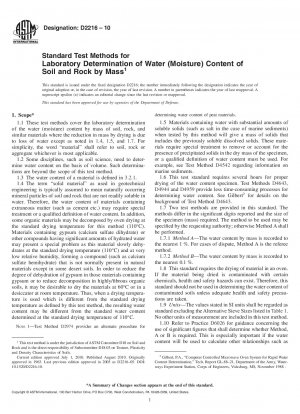ASTM D2216-10
Standard Test Methods for Laboratory Determination of Water (Moisture) Content of Soil and Rock by Mass
- Standard No.
- ASTM D2216-10
- Release Date
- 2010
- Published By
- American Society for Testing and Materials (ASTM)
- Status
- Replace By
- ASTM D2216-19
- Latest
- ASTM D2216-19
- Scope
For many materials, the water content is one of the most significant index properties used in establishing a correlation between soil behavior and its index properties.
The water content of a material is used in expressing the phase relationships of air, water, and solids in a given volume of material.
In fine-grained (cohesive) soils, the consistency of a given soil type depends on its water content. The water content of a soil, along with its liquid and plastic limits as determined by Test Method D4318, is used to express its relative consistency or liquidity index.
Note 28212;The quality of the result produced by this standard is dependent on the competence of the personnel performing it, and the suitability of the equipment and facilities used. Agencies that meet the criteria of Practice D3740 are generally considered capable of competent and objective testing/sampling/inspection/etc. Users of this standard are cautioned that compliance with Practice D3740 does not in itself ensure reliable results. Reliable results depend on many factors; Practice D3740 provides a means of evaluating some of those factors.
1.1 These test methods cover the laboratory determination of the water (moisture) content by mass of soil, rock, and similar materials where the reduction in mass by drying is due to loss of water except as noted in 1.4, 1.5, and 1.7. For simplicity, the word “material” shall refer to soil, rock or aggregate whichever is most applicable.
1.2 Some disciplines, such as soil science, need to determine water content on the basis of volume. Such determinations are beyond the scope of this test method.
1.3 The water content of a material is defined in 3.2.1.
1.4 The term “solid material” as used in geotechnical engineering is typically assumed to mean naturally occurring mineral particles of soil and rock that are not readily soluble in water. Therefore, the water content of materials containing extraneous matter (such as cement etc.) may require special treatment or a qualified definition of water content. In addition, some organic materials may be decomposed by oven drying at the standard drying temperature for this method (110°C). Materials containing gypsum (calcium sulfate dihydrate) or other compounds having significant amounts of hydrated water may present a special problem as this material slowly dehydrates at the standard drying temperature (110°C) and at very low relative humidity, forming a compound (such as calcium sulfate hemihydrate) that is not normally present in natural materials except in some desert soils. In order to reduce the degree of dehydration of gypsum in those materials containing gypsum or to reduce decomposition in highly/fibrous organic soils, it may be desirable to dry the materials at 60°C or in a desiccator at room temperature. Thus, when a drying temperature is used which is different from the standard drying temperature as defined by this test method, the resulting water content may be different from the standard water content determined at the standard drying temperature of 110°C.
Note 18212;......
ASTM D2216-10 Referenced Document
- ASTM D2974 Standard Test Methods for Determining the Water (Moisture) Content, Ash Content, and Organic Material of Peat and Other Organic Soils
- ASTM D3740 Standard Practice for Minimum Requirements for Agencies Engaged in the Testing and/or Inspection of Soil and Rock as Used in Engineering Design and Construction
- ASTM D4220 Standard Practices for Preserving and Transporting Soil Samples
- ASTM D4318 Standard Test Methods for Liquid Limit, Plastic Limit, and Plasticity Index of Soils
- ASTM D4542 Standard Test Method for Pore Water Extraction and Determination of the Soluble Salt Content of Soils by Refractometer
- ASTM D4643 Standard Test Method for Determination of Water Content of Soil and Rock by Microwave Oven Heating
- ASTM D4753 Standard Specification for Evaluating, Selecting, and Specifying Balances and Scales for Use in Soil, Rock, and Construction Materials Testing
- ASTM D4944 Standard Test Method for Field Determination of Water (Moisture) Content of Soil by the Calcium Carbide Gas Pressure Tester Method
- ASTM D4959 Standard Test Method for Determination of Water Content of Soil By Direct Heating
- ASTM D5079 Standard Practices for Preserving and Transporting Rock Core Samples
- ASTM D6026 Standard Practice for Using Significant Digits in Geotechnical Data
- ASTM D653 Standard Terminology Relating to Soil, Rock, and Contained Fluids
- ASTM D7263 Standard Test Methods for Laboratory Determination of Density and Unit Weight of Soil Specimens
- ASTM E145 Standard Specification for Gravity-Convection And Forced-Ventilation Ovens
ASTM D2216-10 history
- 2019 ASTM D2216-19 Standard Test Method for Laboratory Determination of Water (Moisture) Content of Soil and Rock by Mass
- 2010 ASTM D2216-10 Standard Test Methods for Laboratory Determination of Water (Moisture) Content of Soil and Rock by Mass
- 2005 ASTM D2216-05 Standard Test Methods for Laboratory Determination of Water (Moisture) Content of Soil and Rock by Mass
- 1998 ASTM D2216-98 Standard Test Method for Laboratory Determination of Water (Moisture) Content of Soil and Rock by Mass
- 1971 ASTM D2216-71 Standard Method of Laboratory Determination Of Moisture Content Of Soil
